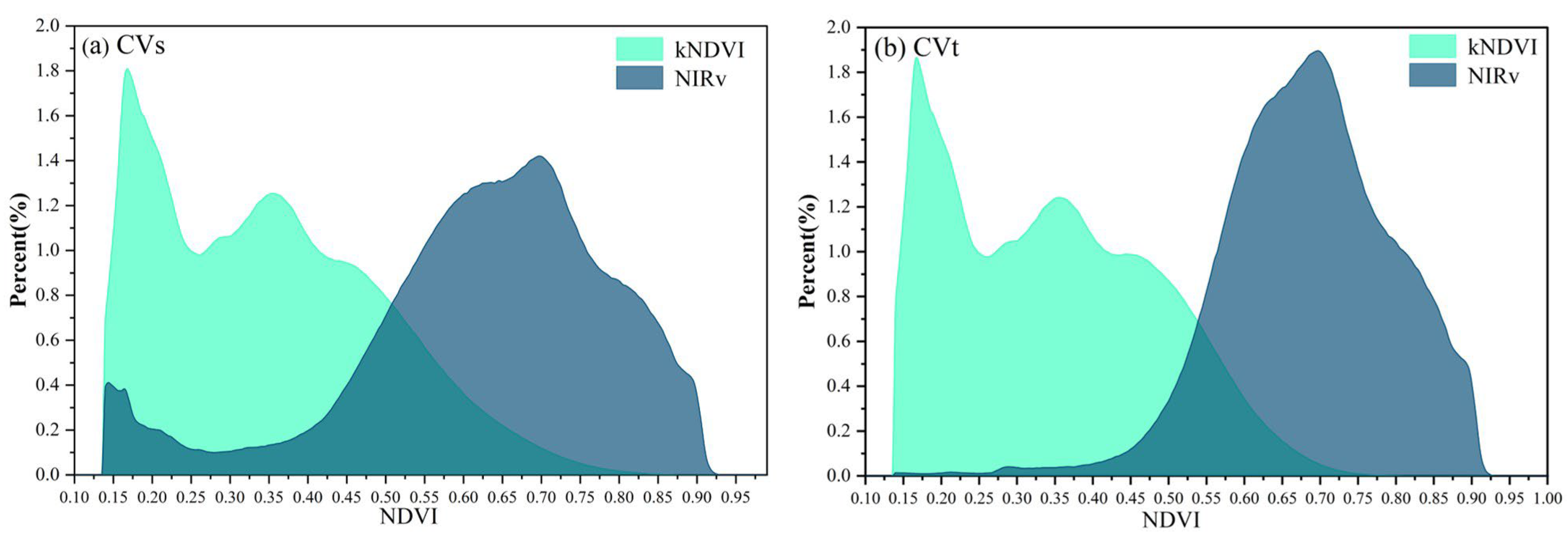Comparison of Satellite-Derived Vegetation Indices for Assessing Vegetation Dynamics in Central Asia
Abstract
1. Introduction
2. Materials and Methods
2.1. Study Area
2.2. Datasets and Pre-Processing
2.3. Data Analysis
3. Results
3.1. Spatiotemporal Variations in NDVI, EVI, NIRv, and kNDVI
3.2. Comparison Between the Spatial and Temporal Heterogeneity of NDVI, EVI, NIRv, and kNDVI
3.3. Correlation Between the Indices, and Temperature and Precipitation
3.4. Comparison of CVI of NDVI, EVI, NIRv, and kNDVI
4. Discussion
5. Conclusions
Author Contributions
Funding
Data Availability Statement
Conflicts of Interest
References
- Huang, J.P.; Yu, H.P.; Guan, X.D.; Wang, G.Y.; Guo, R.X. Accelerated dryland expansion under climate change. Nat. Clim. Change 2016, 6, 166–171. [Google Scholar] [CrossRef]
- Lewin, A.; Murali, G.; Rachmilevitch, S.; Roll, U. Global evaluation of current and future threats to drylands and their vertebrate biodiversity. Nat. Ecol. Evol. 2024, 8, 1448–1458. [Google Scholar] [CrossRef] [PubMed]
- de Oliveira, M.L.; dos Santos, C.A.C.; de Oliveira, G.; Perez-Marin, A.M.; Santos, C.A.G. Effects of human-induced land degradation on water and carbon fluxes in two different Brazilian dryland soil covers. Sci. Total Environ. 2021, 792, 148458. [Google Scholar] [CrossRef] [PubMed]
- Yin, P.; Li, C.H.; Wei, Y.F.; Zhang, L.; Liu, C.; Chen, J.H.; Liu, Y.F.; Xiong, X.T. Impact of relative temperature changes on vegetation growth in China from 2001 to 2017. J. Clean. Prod. 2024, 451, 142062. [Google Scholar] [CrossRef]
- Chen, Z.; Liu, J.Y.; Hou, X.T.; Fan, P.Y.; Qian, Z.H.; Li, L.; Zhang, Z.S.; Feng, G.L.; Li, B.L.; Sun, G.Q. Detection and Attribution of Greening and Land Degradation of Dryland Areas in China and America. Remote Sens. 2023, 15, 2688. [Google Scholar] [CrossRef]
- Hou, L.; Xi, W.M.; Zhang, S.X. Effect of Understory on a Natural Secondary Forest Ecosystem Carbon Budget. Russ. J. Ecol. 2015, 46, 51–58. [Google Scholar] [CrossRef]
- Cong, W.W.; Li, X.Y.; Pan, X.B.; Liu, X.P.; Lu, Q.; Wang, F. A new scientific framework of dryland ecological quality assessment based on 1OAO principle. Ecol. Indic. 2022, 136, 108595. [Google Scholar] [CrossRef]
- Dacal, M.; García-Palacios, P.; Asensio, S.; Cano-Díaz, C.; Gozalo, B.; Ochoa, V.; Maestre, F.T. Contrasting mechanisms underlie short- and longer-term soil respiration responses to experimental warming in a dryland ecosystem. Glob. Change Biol. 2020, 26, 5254–5266. [Google Scholar] [CrossRef]
- Lu, G.; Chen, X.; Wang, J.; Wu, C. Research Progresses on the Effects of Global Change on the Microbes of Plant-site Interface in Alpine Grassland Ecosystem. Acta Agrestia Sin. 2014, 22, 234–242. [Google Scholar]
- Gorji, T.; Sertel, E.; Tanik, A. Monitoring soil salinity via remote sensing technology under data scarce conditions: A case study from Turkey. Ecol. Indic. 2017, 74, 384–391. [Google Scholar] [CrossRef]
- Zhiqiang, W.; Baoyuan, L.I.U.; Chunxing, H.A.I. Effects of Soil Depth on Vegetation Cover and Above Ground Biomass in East Part of Inner Mongolia. J. Soil Water Conserv. 2007, 21, 164–167. [Google Scholar]
- Linderholm, H.W. Growing season changes in the last century. Agric. For. Meteorol. 2006, 137, 1–14. [Google Scholar] [CrossRef]
- Huete, A.; Didan, K.; Miura, T.; Rodriguez, E.P.; Gao, X.; Ferreira, L.G. Overview of the radiometric and biophysical performance of the MODIS vegetation indices. Remote Sens. Environ. 2002, 83, 195–213. [Google Scholar] [CrossRef]
- Badgley, G.; Field, C.B.; Berry, J.A. Canopy near-infrared reflectance and terrestrial photosynthesis. Sci. Adv. 2017, 3, e1602244. [Google Scholar] [CrossRef] [PubMed]
- Camps-Valls, G.; Campos-Taberner, M.; Moreno-Martínez, A.; Walther, S.; Duveiller, G.; Cescatti, A.; Mahecha, M.D.; Muñoz-Marí, J.; García-Haro, F.J.; Guanter, L.; et al. A unified vegetation index for quantifying the terrestrial biosphere. Sci. Adv. 2021, 7, eabc7447. [Google Scholar] [CrossRef]
- Gogoi, J.; Newlands, N.K.; Mehrabi, Z.; Coops, N.C.; Ramankutty, N. Assessing the Performance of Satellite-Based Models for Crop Yield Estimation in the Canadian Prairies. Can. J. Remote Sens. 2023, 49, 2252926. [Google Scholar] [CrossRef]
- Rasul, A.; Balzter, H.; Smith, C. Diurnal and Seasonal Variation of Surface Urban Cool and Heat Islands in the Semi-Arid City of Erbil, Iraq. Climate 2016, 4, 42. [Google Scholar] [CrossRef]
- Brenes, C.L.M.; Jones, K.W.; Schlesinger, P.; Robalino, J.; Vierling, L. The impact of protected area governance and management capacity on ecosystem function in Central America. PLoS ONE 2018, 13, e0205964. [Google Scholar] [CrossRef]
- Zhao, R.F.; Wang, J.F.; Li, L.H.; Zhang, L.H.; Lu, H.T.; Jiang, X.Y.; Chen, X.D.; Han, Z.Y.; Cairang, D.Z.; Wang, H.; et al. Evaluation of alpine wetland ecological degradation based on alpine wetland degradation index: A case study in the first meander of the Yellow River. Ecol. Indic. 2024, 158, 111414. [Google Scholar] [CrossRef]
- Wang, Y.; Zhang, K.; Li, F. Monitoring of fractional vegetation cover change in Xilingol League based on MODIS data over 10 years. J. Arid Land Resour. Environ. 2012, 26, 165–169. [Google Scholar]
- Gao, C.; Ren, X.L.; Fan, L.L.; He, H.L.; Zhang, L.; Zhang, X.Y.; Li, Y.; Zeng, N.; Chen, X.Z. Assessing the Vegetation Dynamics and Its Influencing Factors in Central Asia from 2001 to 2020. Remote Sens. 2023, 15, 4670. [Google Scholar] [CrossRef]
- Zhou, Y.; Zhang, L.; Xiao, J.F.; Williams, C.A.; Vitkovskaya, I.; Bao, A.M. Spatiotemporal transition of institutional and socioeconomic impacts on vegetation productivity in Central Asia over last three decades. Sci. Total Environ. 2019, 658, 922–935. [Google Scholar] [CrossRef] [PubMed]
- Li, M.Y.; Yao, J.Q.; Zheng, J.H. Spatio-Temporal Change and Drivers of the Vegetation Trends in Central Asia. Forests 2024, 15, 1416. [Google Scholar] [CrossRef]
- Lin, M.L.; Chen, C.W.; Wang, Q.B.; Cao, Y.; Shih, J.Y.; Lee, Y.T.; Chen, C.Y.; Wang, S. Fuzzy model-based assessment and monitoring of desertification using MODIS satellite imagery. Eng. Comput. 2009, 26, 745–760. [Google Scholar] [CrossRef]
- Du, H.R.; Tan, M.L.; Zhang, F.; Chun, K.P.; Li, L.H.; Kabir, M.H. Evaluating the effectiveness of CHIRPS data for hydroclimatic studies. Theor. Appl. Climatol. 2024, 155, 1519–1539. [Google Scholar] [CrossRef]
- Chen, T.; Bao, A.M.; Jiapaer, G.; Guo, H.; Zheng, G.X.; Jiang, L.L.; Chang, C.; Tuerhanjiang, L. Disentangling the relative impacts of climate change and human activities on arid and semiarid grasslands in Central Asia during 1982–2015. Sci. Total Environ. 2019, 653, 1311–1325. [Google Scholar] [CrossRef]
- Sun, Y.L.; Shan, M.; Pei, X.R.; Zhang, X.K.; Yang, Y.L. Assessment of the impacts of climate change and human activities on vegetation cover change in the Haihe River basin, China. Phys. Chem. Earth 2020, 115, 102834. [Google Scholar] [CrossRef]
- Holben, B.N. Characteristics of maximum-value composite images from temporal AVHRR data. Int. J. Remote Sens. 1986, 7, 1417–1434. [Google Scholar] [CrossRef]
- Li, H.; Li, B.; Ge, L.; Han, C.; Yang, Q.; Zhang, Y. Temporal and Spatial Characteristics of Vegetation Evolution and Topographic Effects in Fenhe River Basin from 2000 to 2021. Ecol. Environ. Sci. 2023, 32, 439–449. [Google Scholar]
- Yan, J.J.; Zhang, G.P.; Ling, H.B.; Han, F.F. Comparison of time-integrated NDVI and annual maximum NDVI for assessing grassland dynamics. Ecol. Indic. 2022, 136, 108611. [Google Scholar] [CrossRef]
- Butterfield, B.J.; Palmquist, E.; Ralston, B. Hydrological regime and climate interactively shape riparian vegetation composition along the Colorado River, Grand Canyon. Appl. Veg. Sci. 2018, 21, 572–583. [Google Scholar] [CrossRef]
- Tian, Z.; He, X.; Liu, D.; Gao, Y.; Zhao, S.; Geng, Q. Vegetation Drought Monitoring Method Based on Sunlight-Induced Chlorophyll Fluorescence, Involves Using Euclidean Distance Method to Calculate Distance from Any Point in Three-Dimensional Space to Wettest Point, and Obtaining Temperature Fluorescence Precipitation Index. CN115963096-A, 14 April 2023. [Google Scholar]
- Zhang, Z.; Gu, Z.N.; Hu, K.H.; Xu, Y.Y.; Zhao, J.B. Spatial variability between glacier mass balance and environmental factors in the High Mountain Asia. J. Arid. Land 2022, 14, 441–454. [Google Scholar] [CrossRef]
- Zhang, Q.; Yang, J.; Wang, W.; Ma, P.; Lu, G.; Liu, X.; Yu, H.; Fang, F. Climatic warming and humidification in the arid region of Northwest China: Multi-scale characteristics and impacts on ecological vegetation. J. Meteorol. Res. 2021, 35, 113–127. [Google Scholar] [CrossRef]
- Shao, C.Y.; Shuai, Y.M.; Tuerhanjiang, L.; Ma, X.X.; Hu, W.J.; Zhang, Q.L.; Xu, A.G.; Liu, T.; Tian, Y.H.; Wang, C.Y.; et al. Cross-Comparison of Global Surface Albedo Operational Products-MODIS, GLASS, and CGLS. Remote Sens. 2021, 13, 4869. [Google Scholar] [CrossRef]
- Wang, Y.Z.; Hu, C.Z.; Jia, X.P.; Ma, Q.M. Characteristics of Evapotranspiration and Water Consumption of Different Underlying Surfaces in Qaidam Basin. Water 2022, 14, 3469. [Google Scholar] [CrossRef]
- Vawda, M.I.; Lottering, R.; Mutanga, O.; Peerbhay, K.; Sibanda, M.J.S. Comparing the Utility of Artificial Neural Networks (ANN) and Convolutional Neural Networks (CNN) on Sentinel-2 MSI to Estimate Dry Season Aboveground Grass Biomass. Sustainability 2024, 16, 1051. [Google Scholar] [CrossRef]
- Zhu, X.; Chen, X.; Ma, L.; Liu, W.J.P. UAV and Satellite Synergies for Mapping Grassland Aboveground Biomass in Hulunbuir Meadow Steppe. Plants 2024, 13, 1006. [Google Scholar] [CrossRef] [PubMed]
- Ali, S.; Basit, A.; Ni, J.; Manzoor; Khan, F.U.; Sajid, M.; Umair, M.; Makanda, T.A. Impact assessment of drought monitoring events and vegetation dynamics based on multi-satellite remote sensing data over Pakistan. Environ. Sci. Pollut. Res. 2023, 30, 12223–12234. [Google Scholar] [CrossRef] [PubMed]
- Pan, R.; Yan, J.; Xia, Q.; Jin, X.J.W. Enhancing Ecological Security in Ili River Valley: Comprehensive Approach. Water 2024, 16, 1867. [Google Scholar] [CrossRef]
- Ersi, C.; Bayaer, T.; Bao, Y.H.; Bao, Y.L.; Yong, M.; Lai, Q.; Zhang, X.; Zhang, Y.S. Comparison of Phenological Parameters Extracted from SIF, NDVI and NIRv Data on the Mongolian Plateau. Remote Sens. 2023, 15, 187. [Google Scholar] [CrossRef]
- Xiao, C.W.; Zaehle, S.; Yang, H.; Wigneron, J.P.; Schmullius, C.; Bastos, A. Land cover and management effects on ecosystem resistance to drought stress. Earth Syst. Dyn. 2023, 14, 1211–1237. [Google Scholar] [CrossRef]
- Setiawan, Y.; Yoshino, K.; Prasetyo, L.B. Characterizing the dynamics change of vegetation cover on tropical forestlands using 250 m multi-temporal MODIS EVI. Int. J. Appl. Earth Obs. Geoinf. 2014, 26, 132–144. [Google Scholar] [CrossRef]
- Radocaj, D.; Jurisic, M.; Rapcan, I.; Domazetovic, F.; Milosevic, R.; Plascak, I. An Independent Validation of SoilGrids Accuracy for Soil Texture Components in Croatia. Land 2023, 12, 1034. [Google Scholar] [CrossRef]
- Jones, A.L.; Ormondroyd, A.; Hayes, F.; Jeffers, E.S. Reflections of stress: Ozone damage in broadleaf saplings can be identified from hyperspectral leaf reflectance. Environ. Pollut. 2024, 360, 124642. [Google Scholar] [CrossRef] [PubMed]
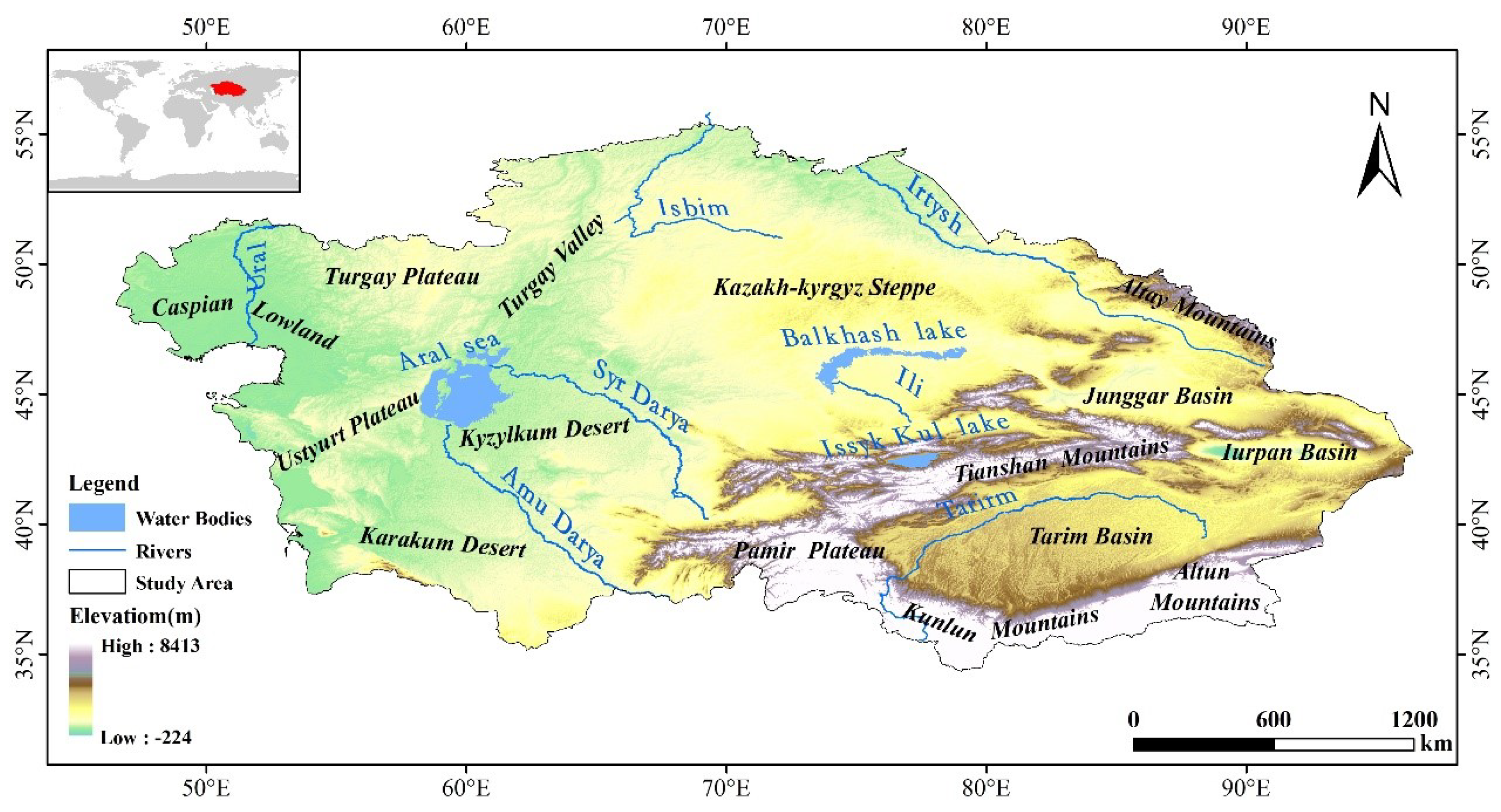
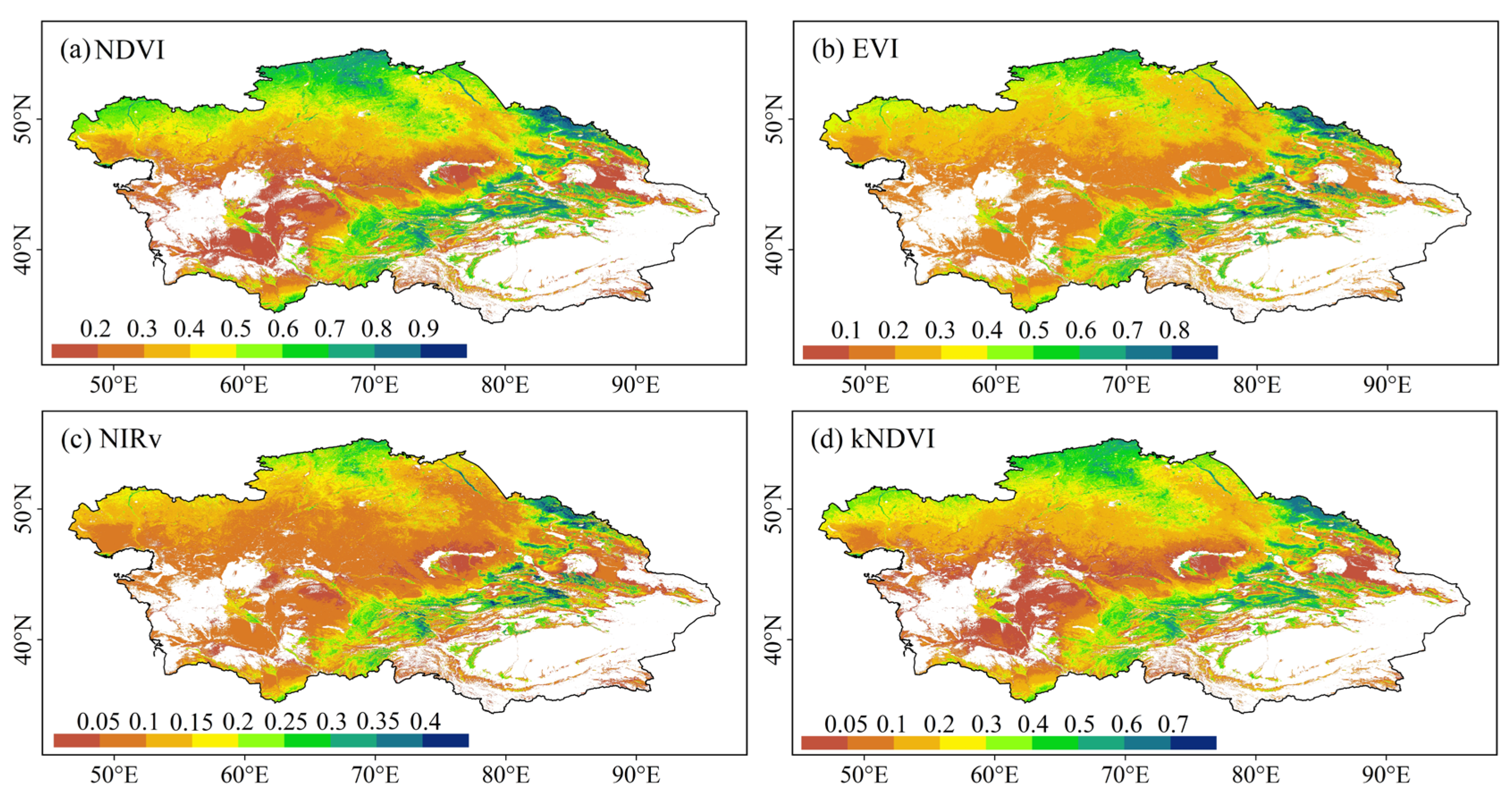
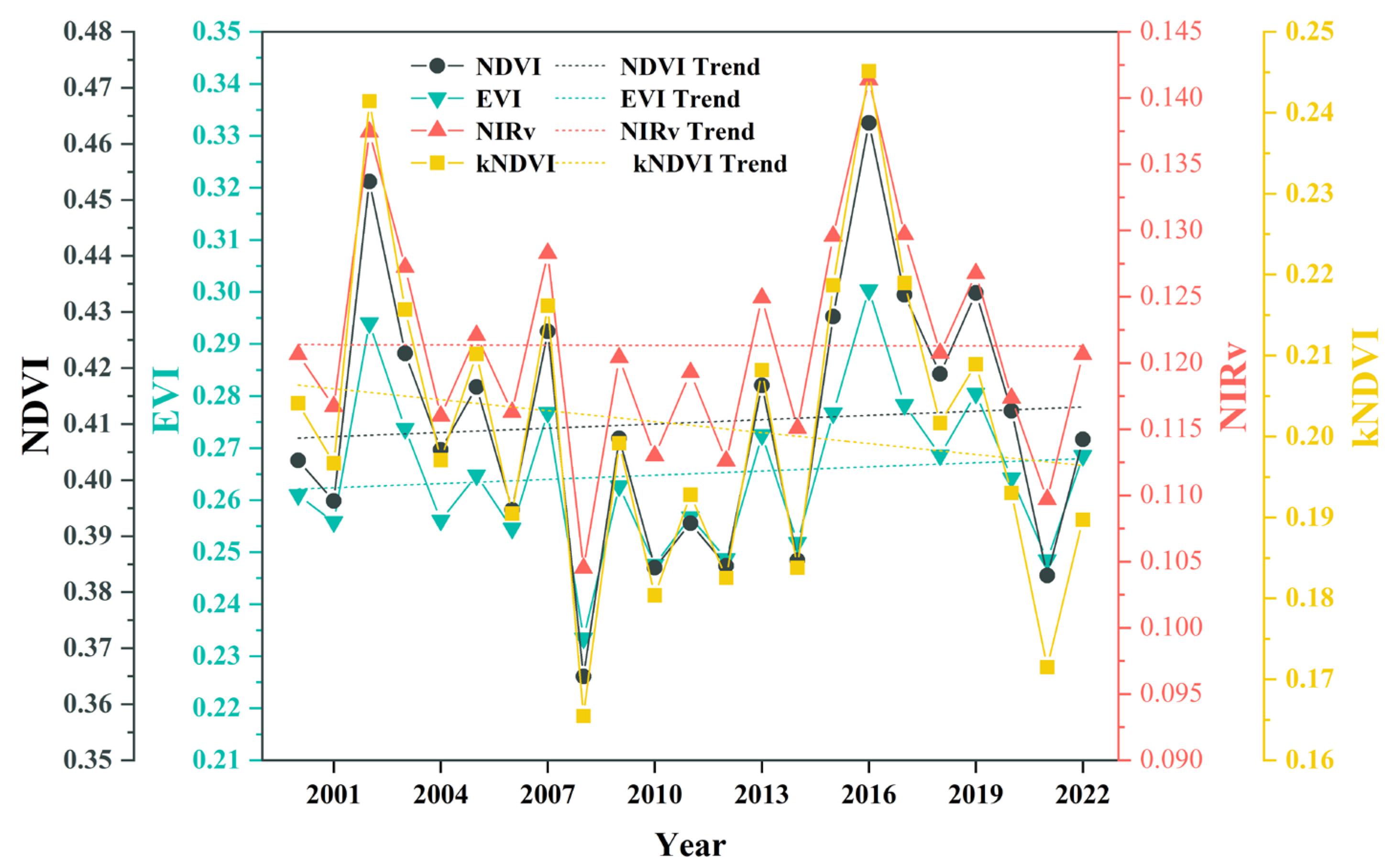
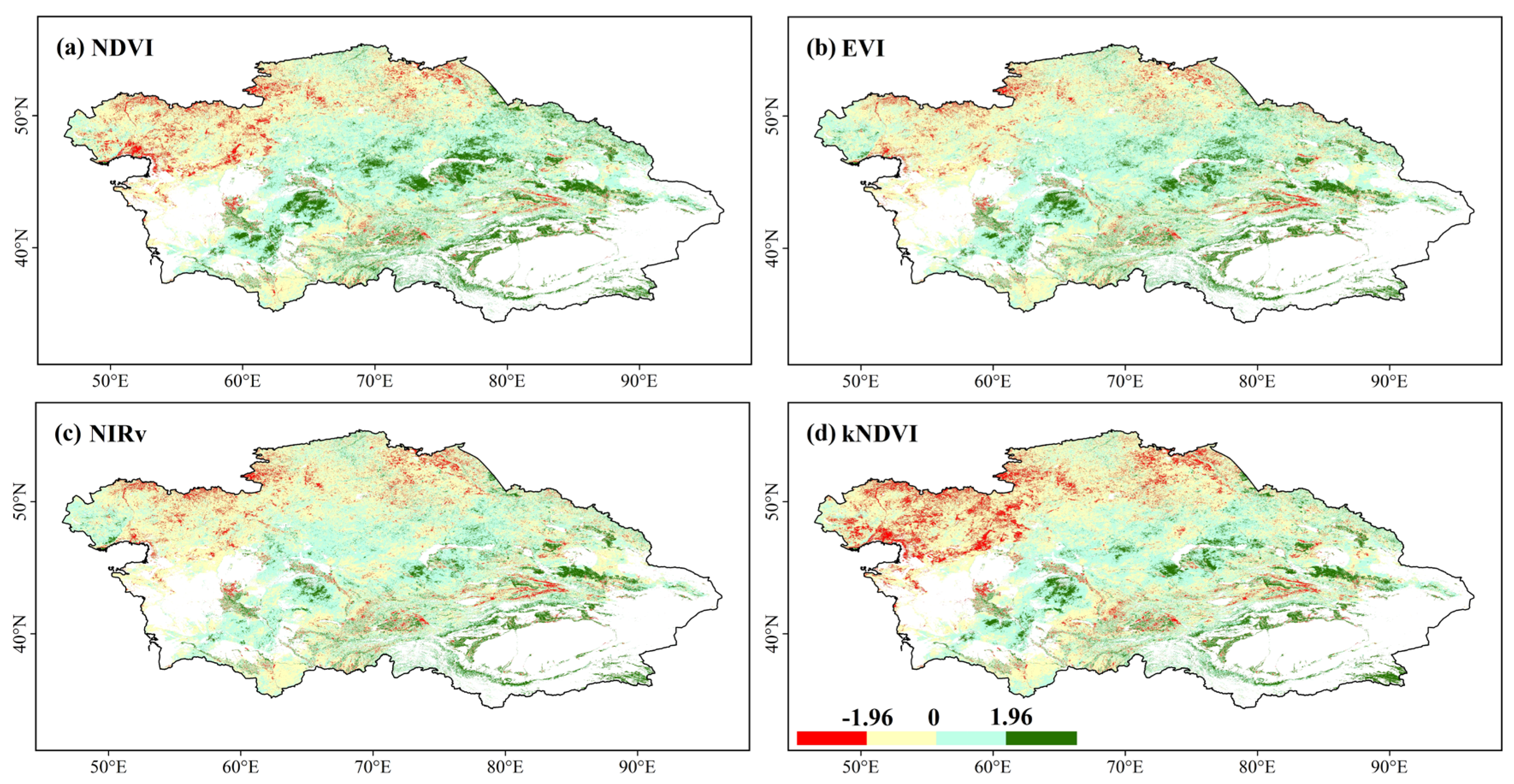
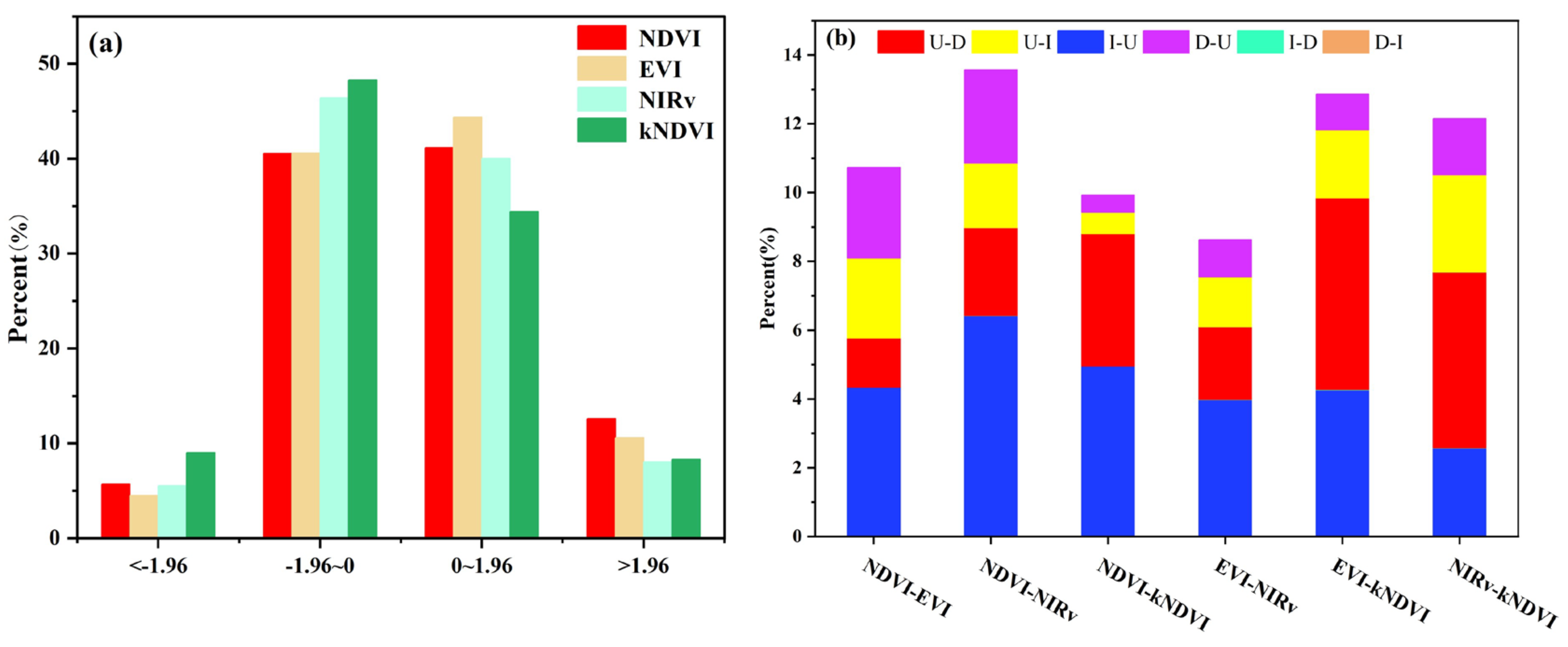
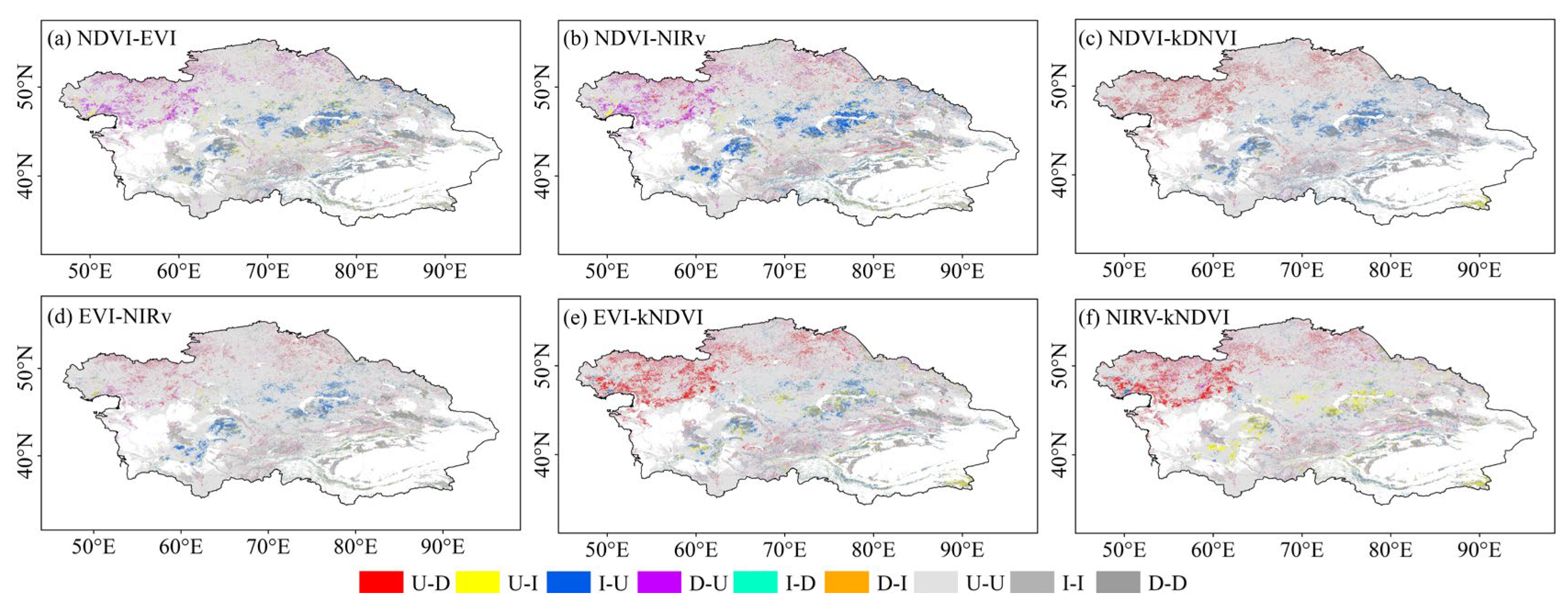
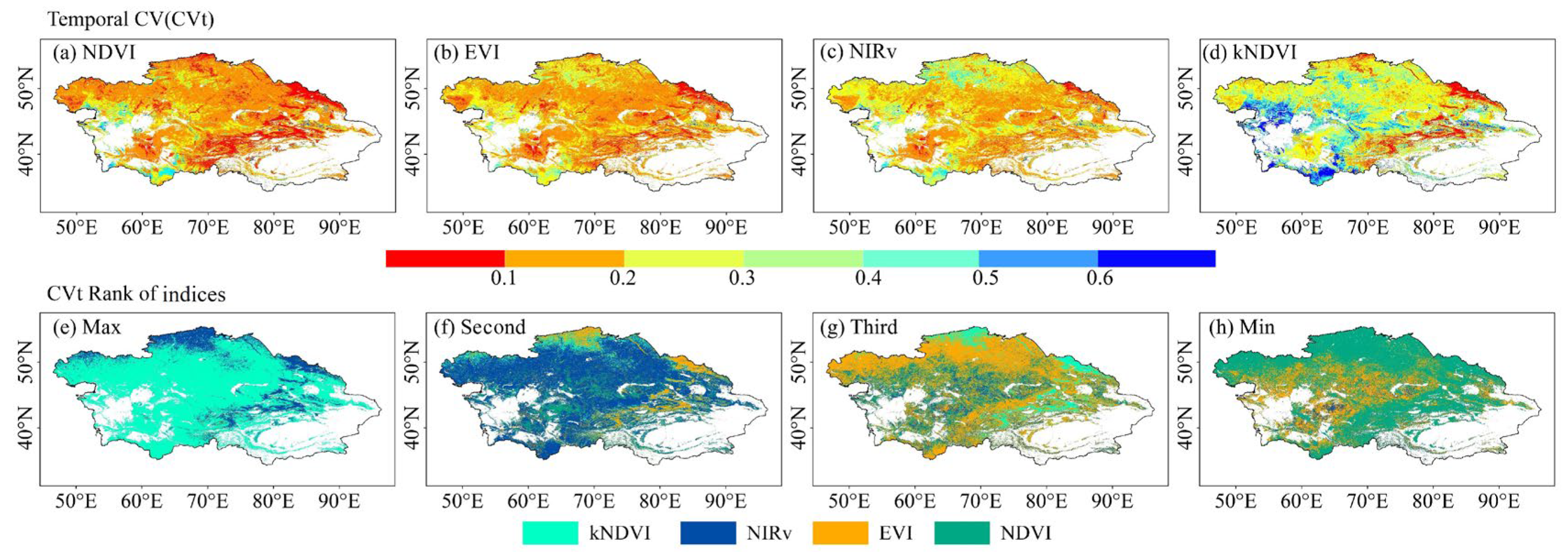

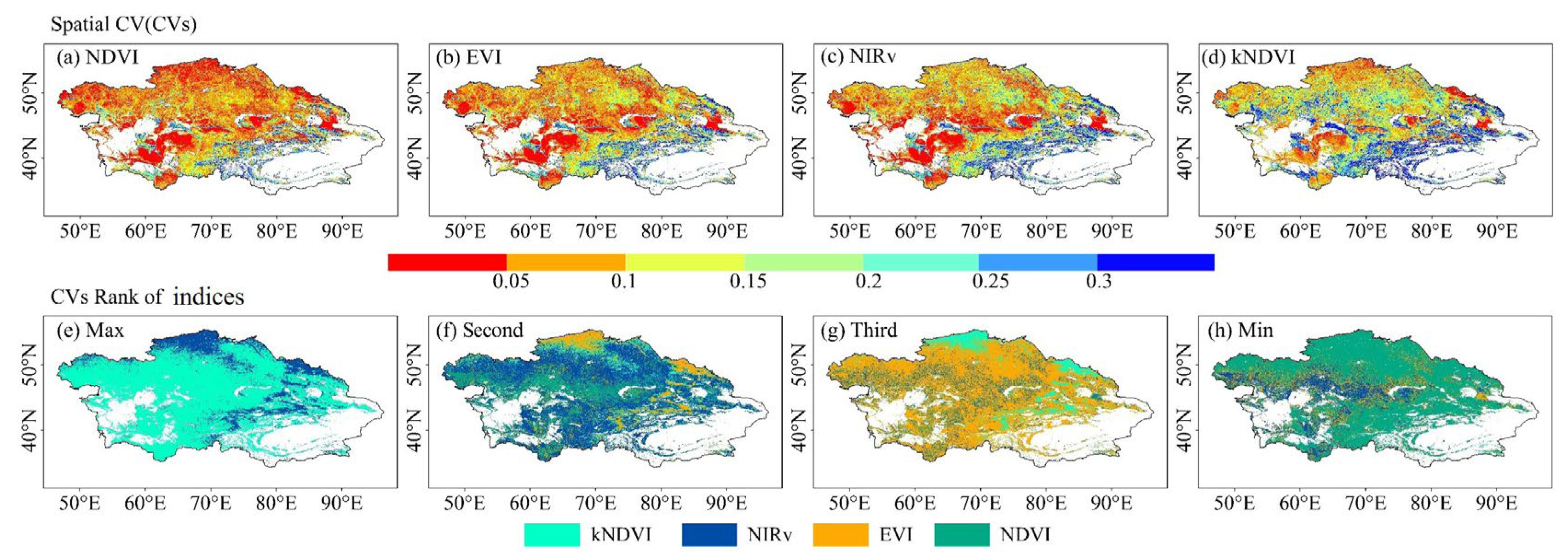
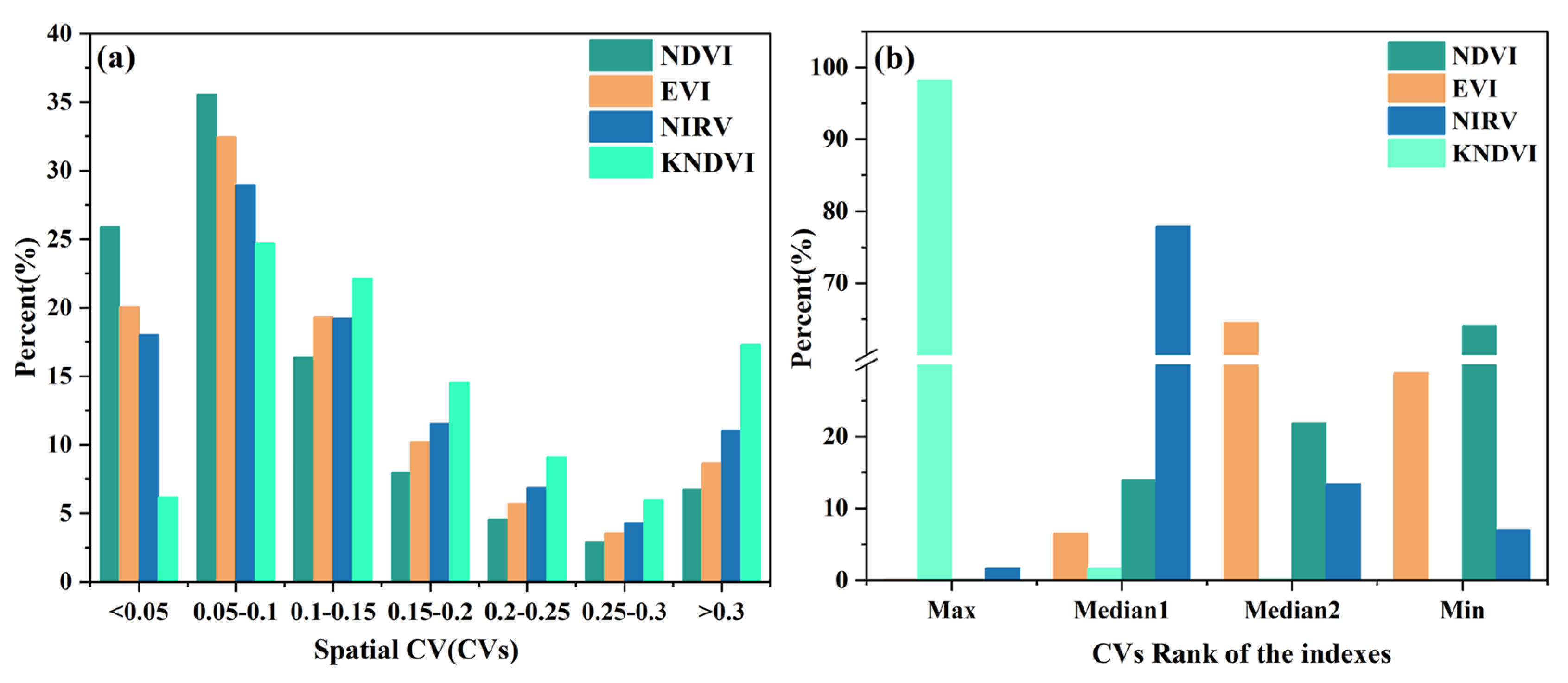
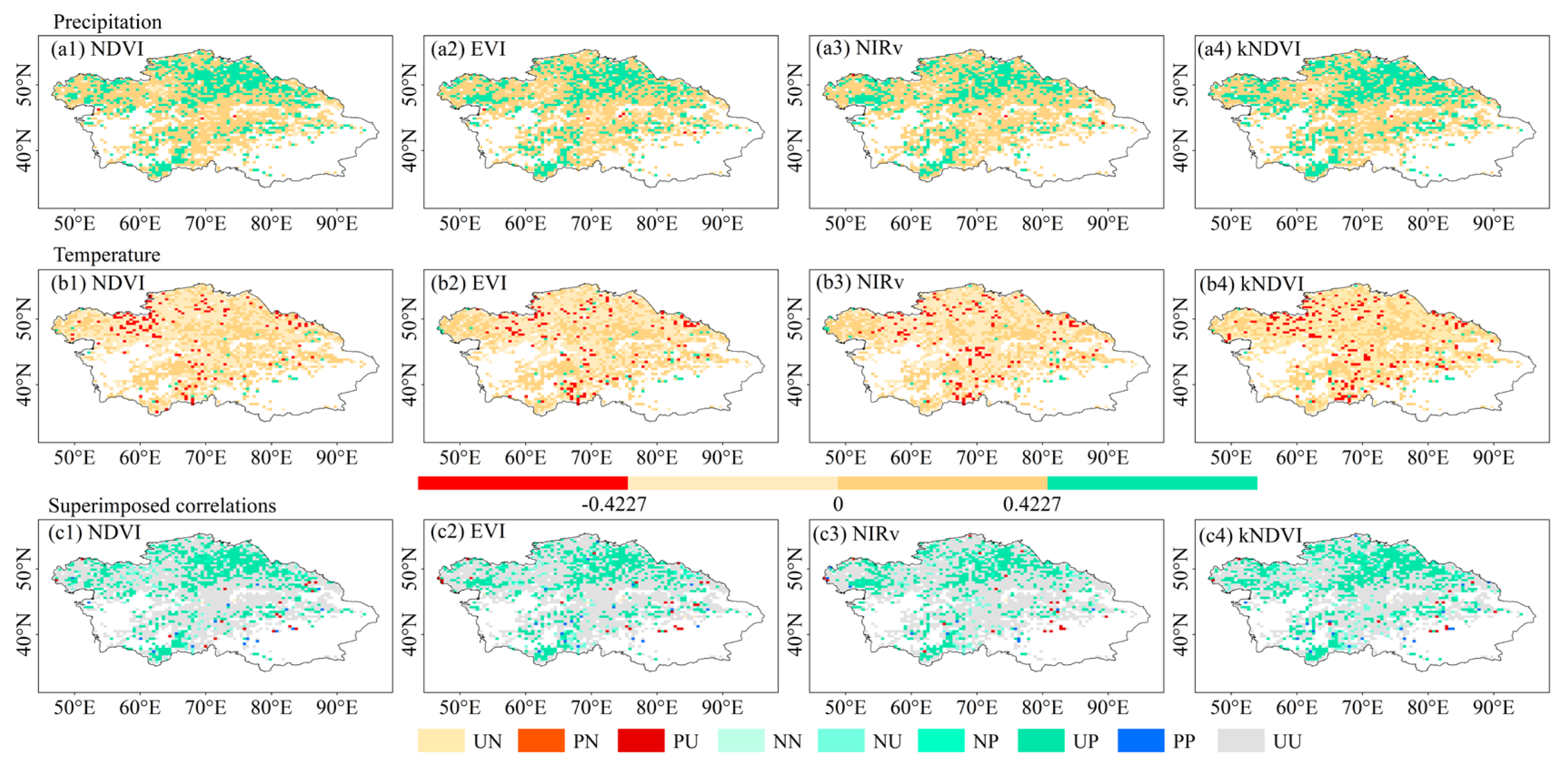

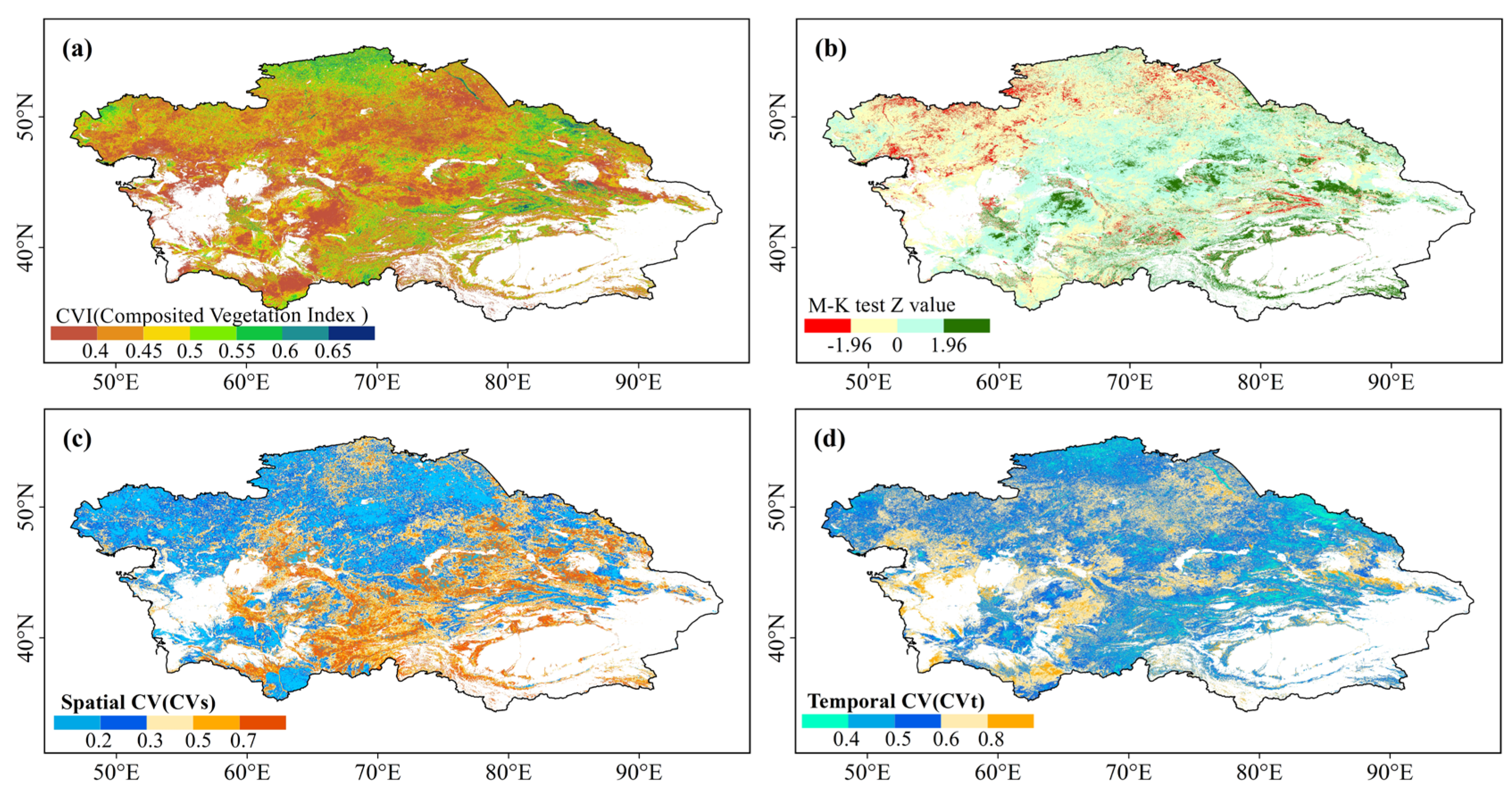
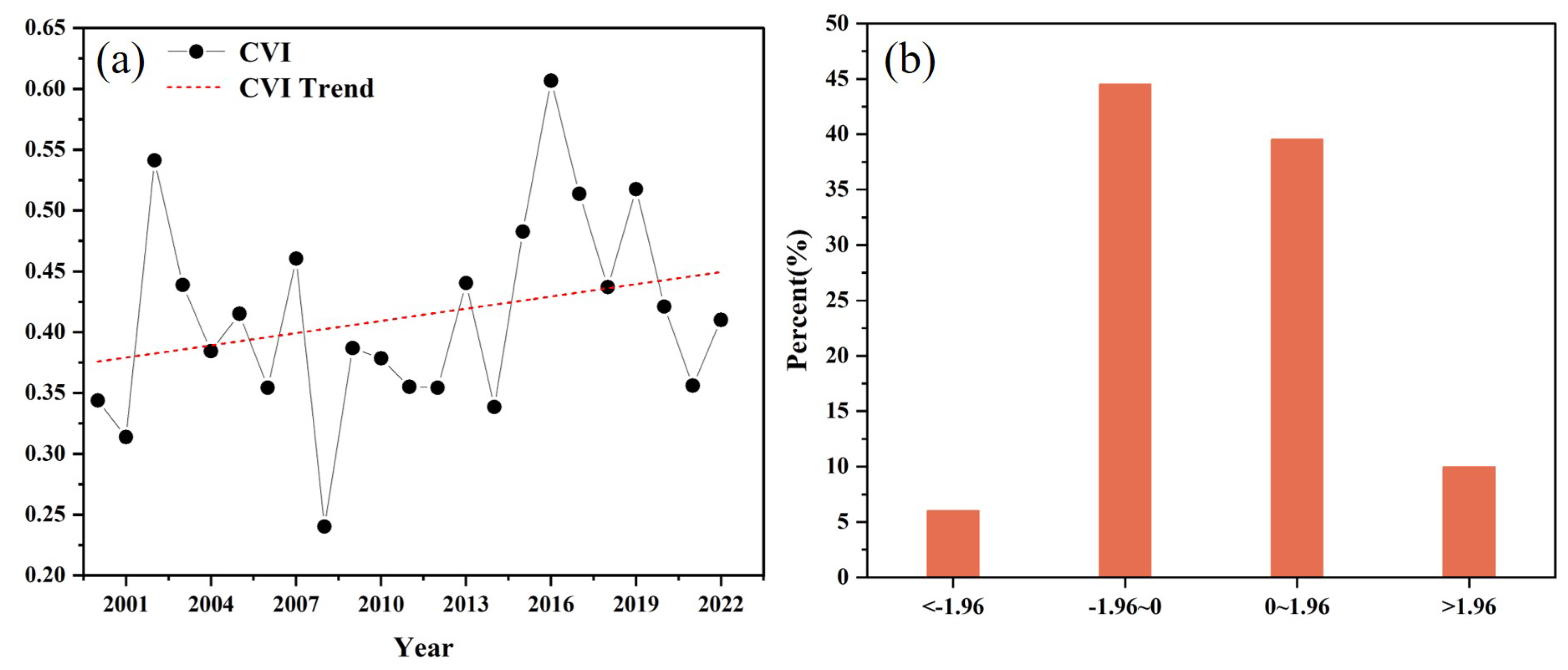
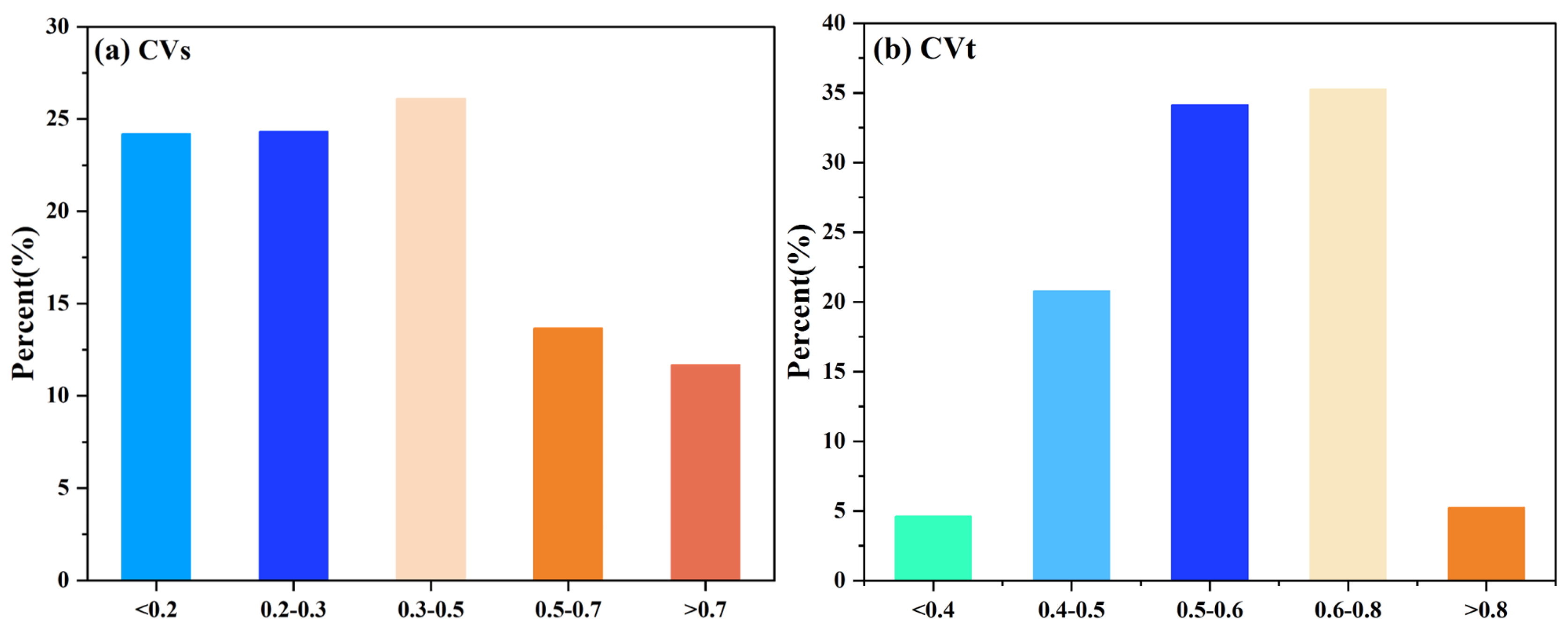


Disclaimer/Publisher’s Note: The statements, opinions and data contained in all publications are solely those of the individual author(s) and contributor(s) and not of MDPI and/or the editor(s). MDPI and/or the editor(s) disclaim responsibility for any injury to people or property resulting from any ideas, methods, instructions or products referred to in the content. |
© 2025 by the authors. Licensee MDPI, Basel, Switzerland. This article is an open access article distributed under the terms and conditions of the Creative Commons Attribution (CC BY) license (https://creativecommons.org/licenses/by/4.0/).
Share and Cite
Li, Q.; Cheng, J.; Yan, J.; Zhang, G.; Ling, H. Comparison of Satellite-Derived Vegetation Indices for Assessing Vegetation Dynamics in Central Asia. Water 2025, 17, 684. https://doi.org/10.3390/w17050684
Li Q, Cheng J, Yan J, Zhang G, Ling H. Comparison of Satellite-Derived Vegetation Indices for Assessing Vegetation Dynamics in Central Asia. Water. 2025; 17(5):684. https://doi.org/10.3390/w17050684
Chicago/Turabian StyleLi, Qian, Junhui Cheng, Junjie Yan, Guangpeng Zhang, and Hongbo Ling. 2025. "Comparison of Satellite-Derived Vegetation Indices for Assessing Vegetation Dynamics in Central Asia" Water 17, no. 5: 684. https://doi.org/10.3390/w17050684
APA StyleLi, Q., Cheng, J., Yan, J., Zhang, G., & Ling, H. (2025). Comparison of Satellite-Derived Vegetation Indices for Assessing Vegetation Dynamics in Central Asia. Water, 17(5), 684. https://doi.org/10.3390/w17050684





